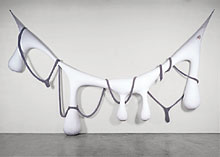
Ernesto Neto, We Live in a Symbiotic Love, 2001. Styrofoam, stockings, and lavender, 386.1 x 363.2 x 41.9 cm. Solomon R. Guggenheim Museum, New York, purchased with funds contributed by the International Director’s Council and Executive Committee Members: Ann Ames, Edythe Broad, Henry Buhl, Elaine Terner Cooper, Dimitris Daskalopoulos, Harry David, Gail May Engelberg, Ronnie Heyman, Dakis Joannou, Cindy Johnson, Barbara Lane, Linda Macklowe, Peter Norton, Willem Peppler, Denise Rich, Simonetta Seragnoli, David Teiger, Ginny Williams, and Elliot K. Wolk 2001.39. Photo by Marc Lutrell.
![]()
The selection of contemporary work presented in Brazil: Body and Soul suggests the multiplicity of artistic strategies employed today, much of which sets up vital parallels with the art of Brazil’s past. Lygia Pape serves as an important link between the Neo-Concrete generation of the 1950s and 1960s and contemporary artists. Her Tupinambá Cloak is inspired by one of the outstanding indigenous pieces in the show. In Regina Silveira’s The Saint’s Paradox (1994), a small wood carving of Saint James the Apostle rests on a pedestal in the center of the exhibition space. The enormous shadow that he appears to cast is not his, but an ironic distortion of the shadow that would be cast by a military monument by Modernist Victor Brecheret, which is located in a public square in São Paulo. In Antonio Manuel’s Phantom (1995), large and small pieces of carbon hang from strings throughout the exhibition space, creating a universe of floating black elements. Within this threatening maze is an image of a hooded individual, a witness photographed while describing a massacre of street children by the police in Rio de Janeiro.
Accumulation, juxtapositions of materials and surfaces, and magnetic tensions are all elements of Tunga’s work. While his large-scale installations suggest inexorable mass, they also imply profound sensuality; indeed, references to body parts, skin, and hair are intrinsic to Tunga’s visual vocabulary. Literal interaction between the viewer and the work of art is a quintessential element in the environments created by Ernesto Neto. His most ambitious works embrace the spectator in total environments made of nylon netting or flesh-colored Lycra. In an ironic commentary on the past, Adriana Verejão employs visual quotations of architectural elements such as tile decorations from Brazil’s colonial period. An urgent sense of corporeality is also conveyed by the body fragments and extrusions of flesh that often punctuate her work. While Miguel Rio Branco and Vik Muniz are worlds apart in their sensibilities, both artists’ photography-based works demonstrate a concern for fragmentary appearances, the fleeting view and chance occurences. Rio Branco’s light-saturated photographs are often shocking, both in their intensity and subject matter. Muniz creates elaborate scenarios with ephemeral materials, such as dust, thread, and sugar, which he then photographs; the process and the fugitive quality of the materials are emphasized, as if to suggest organic growth and decay.
—Edward J. Sullivan